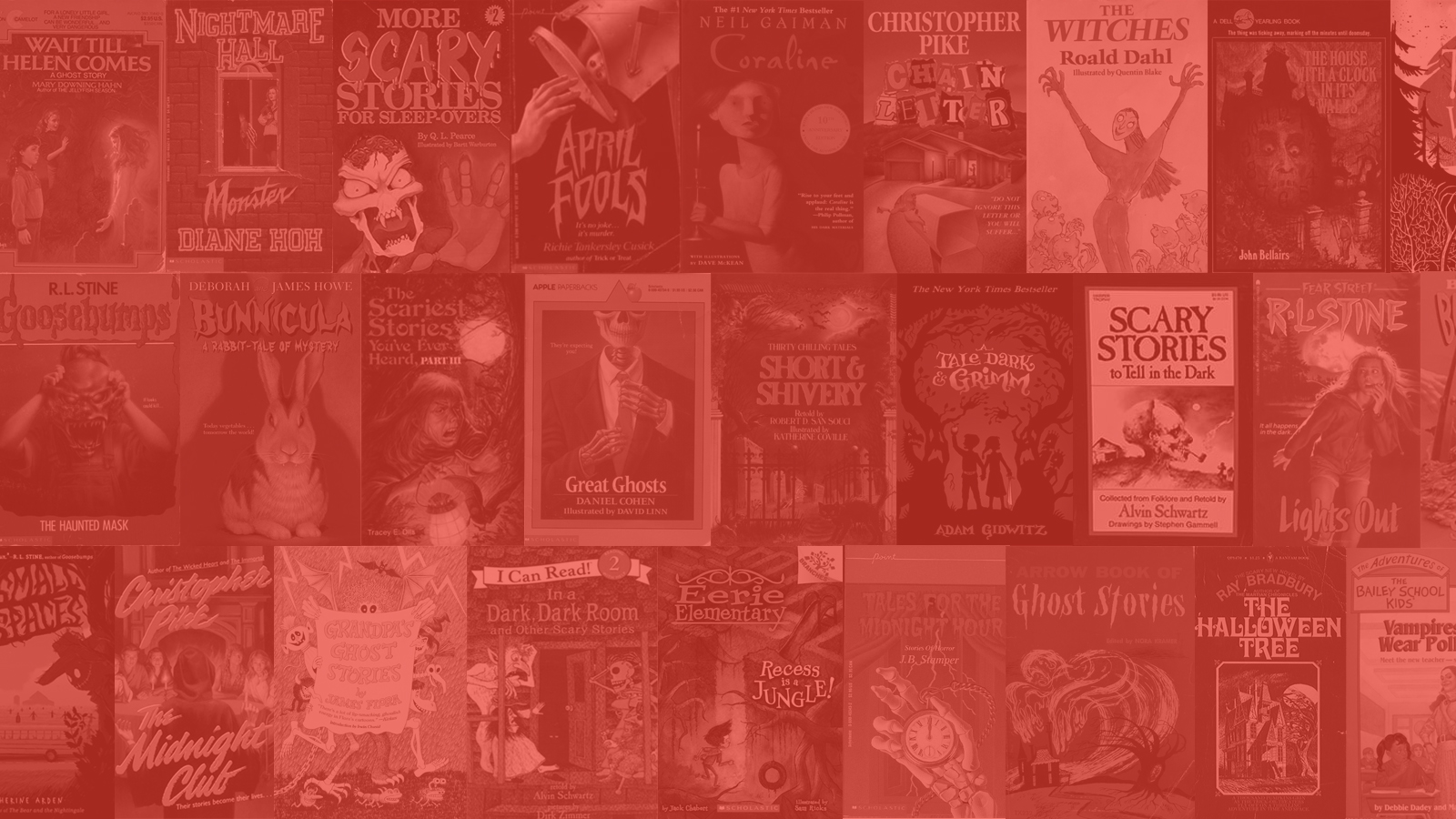80s Children’s Books to Tell in the Dark
Ah, the 80’s.
When a generation reaches a certain age, the time comes to look fondly on our youth and the things we enjoyed at the time. Usually that involves a roughly 30-year cycle, when the 40-somethings (the middle years) are in a position to be creators and are looking back when they were 10-12 years old, when the love of what they do (and what they like) took root in their minds and imaginations.
In the 1980s we saw a surge of pop culture referencing the 1950s… and now in the 2010s-2020s it isn’t surprising that we’re seeing a surge of pop culture nostalgia for the 1980s. It’s natural, but it also allows us to dissect our past. And appreciate it.
When it comes to scary book for kids of the last 50 years, the 1980s was arguably the most influential decade. Author and book series that have become synonymous with the genre gave birth those years, such as R.L. Stine, Point Horror, and Scary Stories to Tell in the Dark. And many of the foundations that existed before, such as Scholastic Book Orders, went on to spawn other programs that began in the 1980s such as Banned Books Week and in-school book fairs.
It was the 1980s where censorship of children’s books became a focus more than ever before. And the main focus of a large part of that censorship at the time, children’s books that had scary content. It was the years of “satanic panic,” as well as a time when horror was becoming more mainstream than it ever had been before.
Scary Stories to Tell in the Dark
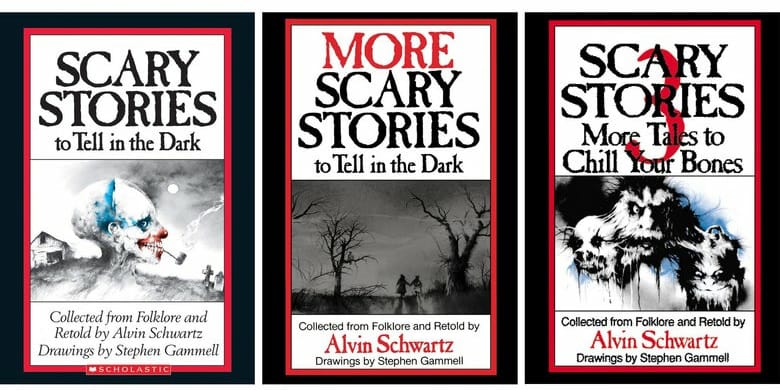
For me my interest began with Scary Stories to Tell in the Dark. It certainly wasn’t the only scary book I read as a child. But I chose it for a subject of a documentary because I thought it was the most interesting example.
It was a title that was in the nonfiction section, based entirely on folklore and urban legends. It diligently cited source material in a way that made it uniquely scholarly (though as I’ve noted, books before it such as Maria Leach’s books did a similar thing). And it is particularly interesting in its historical place in the history of banned books in America. It was ranked the #1 most banned book the first time the American Library Association assembled a decade-long list of challenged books. That will never be taken away.
And Scary Stories to Tell in the Dark had (and still is having) a huge impact. After reading comment after comment about people who struggled to read and were encouraged to do so because of this creepy collection of stories, it became apparent that Scary Stories to Tell in the Dark was a particularly unique book series in pop culture.
Collected by Alvin Schwartz and illustrated by Stephen Gammell, the Scary Stories to Tell in the Dark series was originally published between 1981-1991. For further reading I encourage you to read the ongoing articles I have been posting to Scary Studies as a way to dive deeper into the history, the stories, and the art of the books (here). And of course, watch the documentary, which is nearly an hour and a half of exploration of the books and their impact.
Roald Dahl Books
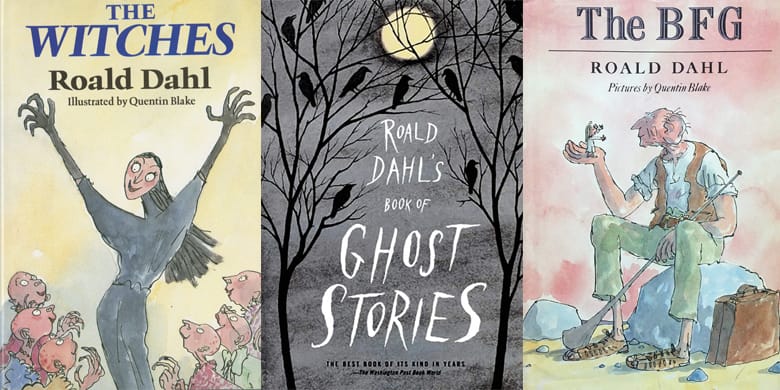
This celebrated author began with some of his biggest successes starting in the 1960s, but one could argue that the 1980s he hit his stride.
In fact, Roald Dahl had become a household name with numerous hugely successful books in the 1960s and 70s with Charlie and the Chocolate Factory, James and the Giant Peach, and others. And yes there were dark themes in those earlier books.
But it’s in the 1980s he took his usual subversions and went quite dark, with Revolting Rhymes (1982), Dirty Beasts (1983), The Witches (1983), and Roald Dahl’s Book of Ghost Stories (1983).
“Children are only half-civilized. They are tougher, courser, and they laugh at things that make us squirm.” The secret of the successful children’s book is that it must work for adults as well, he says, so that they can bear to read it out loud.
It’s possible that this turn toward fictional scary tales as well as adaptations of traditional lore, reinforced with other books like Scary Stories to Tell in the Dark around the same time, all created a certain momentum that began to build in that decade.
Further Reading:
“All the nasty things were edged with humor.” – The Pied Pipers: Interviews with the influential creators of children’s literature
“The detail Dahl lavishes on the threats in his stories is striking, especially for children’s literature.” – Why Are Roald Dahl’s Stories So Creepy?
Buy:
In a Dark Dark Room
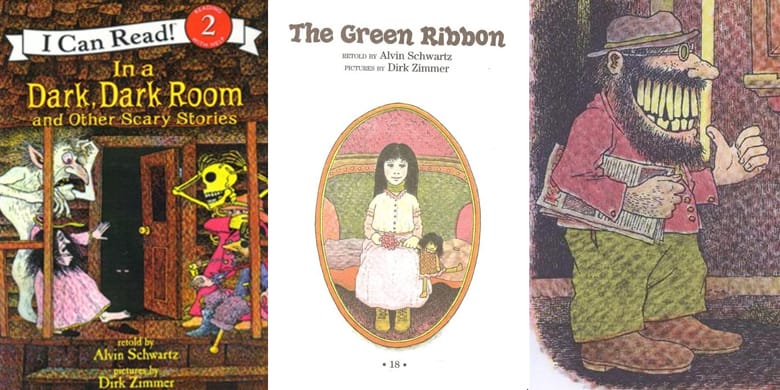
Originally published in 1985, this Alvin Schwartz classic is considered by his wife Barbara Schwartz to be, in some ways, the 4th Scary Stories to Tell in the Dark book. She told me this.
But it is markedly different, because it’s an easy reader. It’s aimed for younger kids, so it has larger font, shorter stories, easier words to read, and although they were quite scary to certain ages, they purposely left out the most gruesome details of any stories. Some of them played up the humor more, which is an important part of many scary stories for kids.
The tale of the Green Ribbon is often cited as the most memorable of the In a Dark Dark Room stories. I talked to wife of the author about it, Barbara Schwartz, as well as I get into the history and meaning behind the Green Ribbon story here: The Girl with the Green Ribbon – The Story Behind the Tale.
I think the example of Scary Stories to Tell in the Dark and In a Dark Dark Room are important in noting the differences in audience and age groups. Children’s book publishers have categories for their books and the intended audience, often separated into middle grade and YA (scary books for teens) but there are more. Obviously In a Dark Dark Room and 5 Grinning Ghosts are meant for certain ages, while many books on this list are meant for older children. So while adults often clump books together into one type (“it’s a scary book for kids”), ultimately as with all children’s books it is important that we always acknowledge that some kids are more ready than others for different levels of scariness. But the categories aren’t meant to be a clear delineation. They are a rough guide.
Daniel Cohen Books
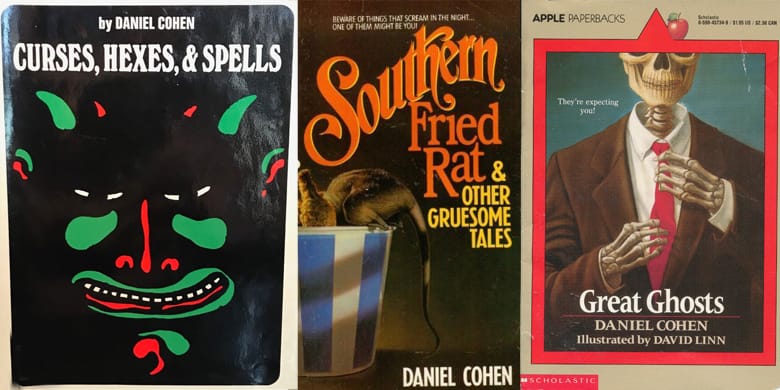
In some ways Daniel Cohen represents the trajectory of scary kids books between the 1970s to 1990s. And it all begins with nonfiction (and censorship).
In 1974 he released Curses, Hexes and Spells which was in the same vein as previous titles from Maria Leach, but focused specifically on folklore tales involving, well, curses hexes and spells. More than likely because of the title and little else, it became known as one of the more challenged books of the era.
He followed it up in the late 80s and early 90s with more scary folktale and urban legend books such as Southern Fried Rat and Other Gruesome Tales (1989), Great Ghosts (1992), and Railway Ghosts and Highway Horrors (1993). Like with Alvin Schwartz, an interest in scary books for kids was linked with real-world tales and the meaning found in the urban legends that get passed on from one generation to the next.
In many ways Daniel Cohens influence in children’s literature is eclipsed by his efforts for justice for his daughter, who was a victim of the bombing of Pan Am Flight 103 over Lockerbie, Scotland in 1988. The last 30 years of his life was dedicated to that fight.
Further Reading:
Buy:
Bunnicula
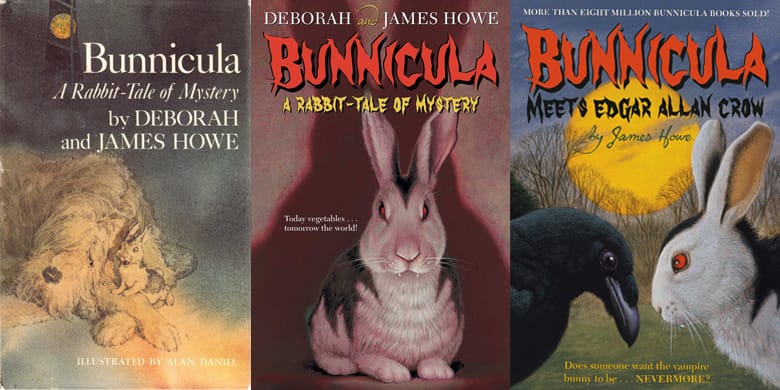
Originally published in 1979 by James Howe and wife Deborah Howe, the Bunnicula books mixed the idea behind old school vampires, a fun pet premise, and detective fiction tropes.
Not as scary as some other books on this list, the vampire premise of Bunnicula was clearly aimed at children who had an interest in darker themes while staying away from the scarier stuff. And it was wildly successful, spawning many subsequent volumes.
Bunnicula has gone on to be known for healthy themes that mix well with the horror implied in the books.
“This girl wrote, ‘I learned from this book to be accepting of someone who’s different. Harold just accepted Bunnicula. He said, He’s different. So what? Chester was suspicious of him and wanted to destroy him.’ There it was. There was my theme.”
Deborah Howe passed away before Bunnicula became the commercial success it did. And James Howe has turned his success into not only a great career in children’s books, but an advocate for the fight against bullying and a prominent representative of LGBT authors.
Further Reading:
“Books & Bullying: Writing to Celebrate Difference” by James Howe
Buy:
Scariest Stories You’ve Ever Heard
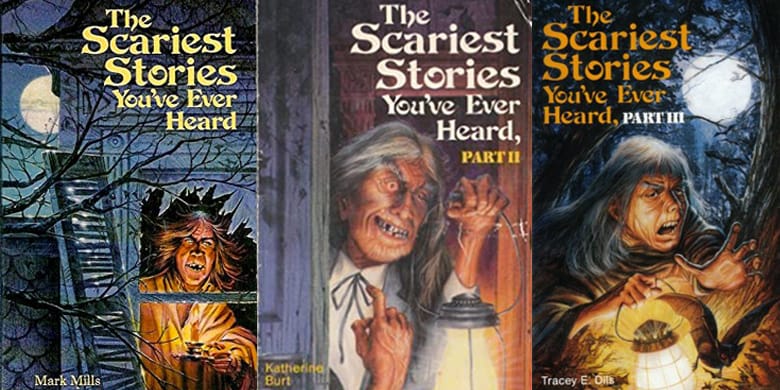
In the last few years of the 1980s, we saw a scary book series that was mostly mimicking the stories and style of Scary Stories to Tell in the Dark. In fact, of the 3 books and 34 stories featured, 9 of the tales were roughly the same exact folk tales and urban legends that were also featured in the Alvin Schwartz books.
That said, these are all oral tradition, and there is no one definitive version. Packaging them for young readers is a noble cause, and many discovered these tales in these books rather than the Schwartz books.
Dark Forces and Twilight: Where Darkness Begins
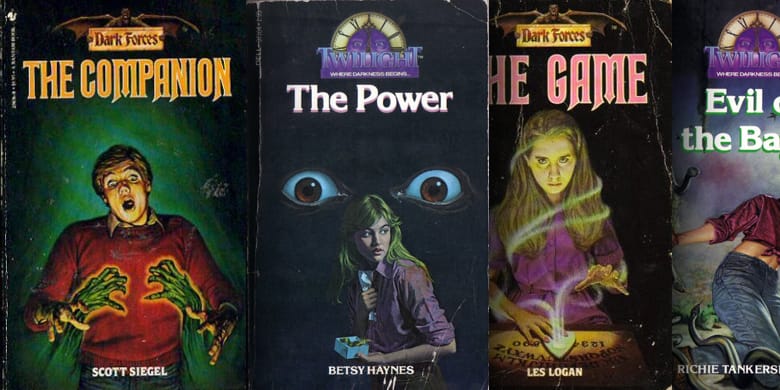
Starting in 1982 and for the following 5 years, both Dell and Bantam (both publishers that long since have been gobbled up by other publishers) each released a series aimed at young adults and their interest in supernatural tales. They are frequently noted as being similar to and competing against each other in many respects.
Authors of the series’ that went on to publish quite a bit more in the scary kids genre include Bruce Coville (known for many titles), Betsey Haynes (Bone Chillers), and Richie Tankersley Cusick (Point Horror and others).
These were in some ways training grounds for what would happen with the Point Horror series and more beginning in the late 1980s and leading to the true catupult of the genre in the 90s.
The Point Horror books began in 1986 with R.L. Stine’s Blind Date. And we all know what became of that guy.
Last Updated on February 2, 2022.

